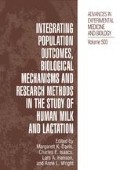Abstract
Observations that exclusive breastfeeding in the early months of life, extended partial breastfeeding and transition to high quality non-breast milk foods have biological benefits are unsurprising from an evolutionary perspective. Nevertheless, in order to ascertain the optimal timing of components of the human weaning process, one must adopt a rigorous comparative biomedical approach. Most research on human milk and lactation therefore uses evidence-based methods and clinical outcomes to quantify the effects of different “doses” of breastfeeding (“none”, “exclusive”, “partial”, “extended”, etc.) and to identify the nutritional, immunological and endocrinological mechanisms mediating such effects. Comparisons among groups of children exposed to different patterns of breastfeeding and complementary feeding show that only some patterns maximize growth and development, energy and nutrient intakes in relation to estimated requirements, and survival for the normal, healthy child.
Access this chapter
Tax calculation will be finalised at checkout
Purchases are for personal use only
Preview
Unable to display preview. Download preview PDF.
References
Mosley, W. and L. Chen. An analytical framework for the study of child survival in developing countries, in Child survival: Strategies for research, edited by W.H. Mosley and L.C. Chen, 1984) p. 25–45.
UNICEF. The state of the world’s children, edited. (Oxford University Press, Oxford, 1997).
Paul, B. Health, culture and community. edited. (Russell Sage Foundation, New York, 1955).
Hahn, R. Anthropology in Public Health: Bridging differences in culture and society. edited. (Oxford University Press, New York, 1999).
Pelto, G., K. Dickin, and P. Engle. A critical link: Interventions for physical growth and psychological development: A review, edited. (Worl Health Organization, Geneva, 2000) 79.
ACC/SCN. Breastfeeding and complementary feeding (Chapter 3), in Fourth Report on the World Nutrition Situation, edited. (United Nations Administrative Committee on Coordination Subcommittee on Nutrition in collaboration with International Food Policy Research Institute, Geneva, 2000) p. 33–41.
McGuire, J. and B. M. Popkin. Beating the zero sum game: Women and nutrition in the third world. United Nations: Administrative Committee on Coordination/Subcommitee on Nutrition: New York, 1990.
Maher, V. Breast-Feeding in Cross-cultural Perspective: Paradoxes and Proposals, in The Anthropology of Breast-Feeding: Natural Law or Social Construct, edited by V. Maher. (Berg Publishers Limited, Oxfrod University Press, Washington, D.C., 1992) p. 1–36.
Anon. Innocenti declaration on the protection, promotion and support of breast -feeding, Ecol. Food Nutr. 26:271–273 (1991).
WHO/UNICEF. Protecting, promoting and supporting breast-feeding. The special role of maternity services. A joint WHO/UNICEF statement, WHO/UNICEF: Geneva, (1989).
Haggerty, P. A. and S. O. Rutstein. Breastfeeding and complementary infant feeding, and the postpartum effects of beastfeeding. DHS Comparative Studies, edited by D.A.H. Surveys. Vol. 30. (Macro International, Inc, Calverton, MD, 1999) 282.
Tedstone, A., N. Dunce, M. Aviles, P. Shetty, and L. Daniels. Effectiveness of interventions to promote healthy feeding in infants under one year of age: a review,edited. (Health Education Authority, UK., London, 1998).
Obermeyer, C. M. and S. Castle. Back to nature? Historical and cross-cultural perspectives on barriers to optimal breastfeeding, Med. Anthropol. 17:39–63 (1997).
WHO, Global data bank on breast-feeding. World Health Organization Nutrition Unit (1996).
Sellen, D. W. Polygyny and child growth in a traditional pastoral society: the case of the Datoga of Tanzania, Human Nature: An Interdisciplinary Biosocial Journal. 10(4):329–371 (1999).
Sellen, D. W. Seasonal ecology and nutritional status of women and children in a Tanzanian pastoral community, Am. J. Hum. Biol. 12(6):758–781 (2000).
Sellen, D. W. Infant and young child feeding practices among African pastoralists: the Datoga of Tanzania, J. Biosoc. Sci. 30(4):481–499 (1998).
Victora, J. P. and E. All. Effects of bottle feeding on infant survival, Archives of Disease in Childhood 66:102–109 (1989).
Schepher-Hughes, N. Infant mortality and infant care: Cultural and economic constraints on nurturing in northest Brazil, Soc. Sci. Med. 19(5):535–546 (1984).
Schepher-Hughes, N. Death without weeping: The violence of everyday life in Brazil, edited. (University of California Press, Berkely, 1992).
Schepher-Hughes, N. Culture, scarcity and maternal thinking: Maternal detachment and infant survival in a Brazilian shantyton, Ethos. 13(4):291–317 (1985).
Samega-Janneh, I. J. Breastfeeding: from biology to policy. in Challenges for the 21st century: A gender perspective on nutrition through the life cycle. 1998. Oslo, Norway: United Nations.
Sellen, D. W. and A. Tedstone. Nutritional needs of refugee children in the UK, J. Roy. Soc. Med. 93:360–364 (2000).
Sellen, D. W. and A. Tedstone. Assessing food security and nutritional well being of preschool refugee children in the United Kingdom, in Food in the migrant experience, edited by A.J. Kershen and A. Penn. (Routledge, London, in press).
Sellen, D. W., A. Tedstone, and J. Frize. Research Development: Young Refugee Children’s Diets and Family Coping Strategies. 2000, The Kings Fund: London. p. 15.
Author information
Authors and Affiliations
Editor information
Editors and Affiliations
Rights and permissions
Copyright information
© 2002 Springer Science+Business Media New York
About this chapter
Cite this chapter
Sellen, D.W. (2002). Sub-Optimal Breast Feeding Practices: Ethnographic approaches to building “Baby Friendly” communities. In: Davis, M.K., Isaacs, C.E., Hanson, L.Å., Wright, A.L. (eds) Integrating Population Outcomes, Biological Mechanisms and Research Methods in the Study of Human Milk and Lactation. Advances in Experimental Medicine and Biology, vol 503. Springer, Boston, MA. https://doi.org/10.1007/978-1-4615-0559-4_26
Download citation
DOI: https://doi.org/10.1007/978-1-4615-0559-4_26
Publisher Name: Springer, Boston, MA
Print ISBN: 978-1-4613-5132-0
Online ISBN: 978-1-4615-0559-4
eBook Packages: Springer Book Archive

